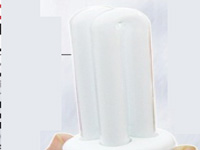Across the world, consumers are being urged to stop buying dated incandescent light bulbs and switch to new spiral fluorescent bulbs, which use about 25 percent of the energy and last 10 times longer. In Britain, there is a Ban the Bulb movement. China is encouraging the change. And the U.S. Congress has set new energy efficiency standards that will make Edison's magical invention obsolete by the year 2014. Now, the question is how to dispose of these compact fluorescent bulbs once they break or quit working. Unlike traditional light bulbs, each of these spiral bulbs has a tiny bit of a dangerous toxin - around 5 milligrams of mercury. And although one dot of mercury might not seem so bad, almost 300 million compact fluorescents were sold in the United States last year. That is already a lot of mercury to throw in the trash, and the amounts will grow ever larger in coming years. Businesses and government recyclers need to start working on more efficient ways to deal with that added mercury. Ellen Silbergeld, a professor of environmental health at Johns Hopkins University in Baltimore, is raising the cry about the moment when millions of these light bulbs start landing in landfills or incinerators all at once. The pig in the waste pipeline, she calls it. Even when warned, public officials are never great at planning. The Environmental Protection Agency focuses mostly on the disposal of one bulb at a time. If you break a fluorescent bulb, there is no need to call in the hazmat team, the agency says. Just clean it up quickly with paper (no vacuuming or brooms), and open the window for a 15-minute douse of fresh air. Tuck the debris into a plastic sack and, if there is no special recycling nearby, discard it in the regular trash. Interestingly, one of the main reasons to use these bulbs is that when they cut down on energy use, they also cut down on mercury emissions from power plants. And even with their mercury innards, these bulbs are still better for the environment than the old ones


